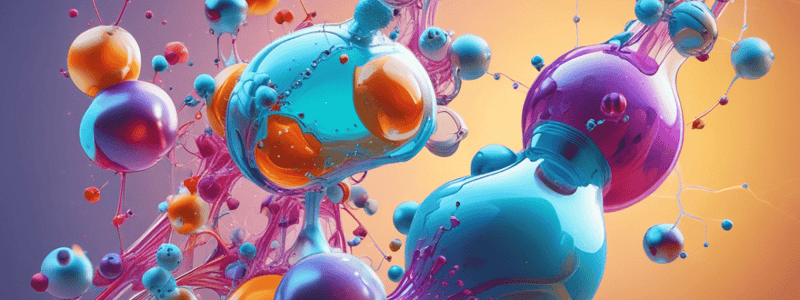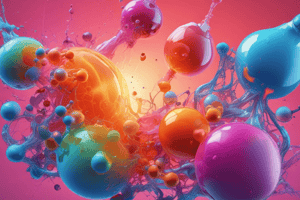Podcast
Questions and Answers
What is the primary function of a catalyst in a reaction?
What is the primary function of a catalyst in a reaction?
- Increase the activation energy
- Change the nature of the reaction
- Consumed by the reaction
- Decrease the activation energy (correct)
Which statement about enzymes is true?
Which statement about enzymes is true?
- Enzymes increase activation energy
- Enzymes are not specific for the reactions they catalyze
- Enzymes change the nature of a reaction
- Enzymes do not change ΔG for a reaction (correct)
What holds the enzyme-substrate complex together?
What holds the enzyme-substrate complex together?
- Hydrogen bonds, electrical attraction, or hydrophobic interactions (correct)
- Covalent bonds only
- Ionic interactions only
- Van der Waals forces
What happens to enzymes in a reaction?
What happens to enzymes in a reaction?
What is the function of the active site in an enzyme?
What is the function of the active site in an enzyme?
Which is NOT a property of enzymes?
Which is NOT a property of enzymes?
What is the role of enzymes regarding activation energy in reactions?
What is the role of enzymes regarding activation energy in reactions?
'Induced fit' refers to what process in enzyme-catalyzed reactions?
'Induced fit' refers to what process in enzyme-catalyzed reactions?
What is the main purpose of metabolic pathways?
What is the main purpose of metabolic pathways?
What is the role of the commitment step in a metabolic pathway?
What is the role of the commitment step in a metabolic pathway?
What is the purpose of feedback (negative) inhibition in a metabolic pathway?
What is the purpose of feedback (negative) inhibition in a metabolic pathway?
What is the relationship between metabolic pathways and homeostasis?
What is the relationship between metabolic pathways and homeostasis?
What is the key difference between reversible and irreversible enzyme inhibition?
What is the key difference between reversible and irreversible enzyme inhibition?
How are metabolic reactions organized within cells?
How are metabolic reactions organized within cells?
What is the role of enzymes in metabolic pathways?
What is the role of enzymes in metabolic pathways?
How does feedback inhibition regulate the activity of a metabolic pathway?
How does feedback inhibition regulate the activity of a metabolic pathway?
Which of the following statements about enzymes is NOT true?
Which of the following statements about enzymes is NOT true?
At the point of saturation, what is the state of the enzyme and substrate?
At the point of saturation, what is the state of the enzyme and substrate?
What is the primary role of an enzyme's active site?
What is the primary role of an enzyme's active site?
Which of the following statements accurately describes the relationship between enzyme and substrate concentrations?
Which of the following statements accurately describes the relationship between enzyme and substrate concentrations?
How is the efficiency of an enzyme typically measured?
How is the efficiency of an enzyme typically measured?
What is the range of turnover rates for enzymes?
What is the range of turnover rates for enzymes?
Which of the following actions is performed by enzymes to facilitate a reaction?
Which of the following actions is performed by enzymes to facilitate a reaction?
What is the primary function of an enzyme's active site during a reaction?
What is the primary function of an enzyme's active site during a reaction?
Which factor is NOT mentioned as a regulator of enzyme activity in the text?
Which factor is NOT mentioned as a regulator of enzyme activity in the text?
What happens to the noncovalent bonds in an enzyme at high temperatures?
What happens to the noncovalent bonds in an enzyme at high temperatures?
What type of inhibitor binds to a site on the enzyme other than the active site?
What type of inhibitor binds to a site on the enzyme other than the active site?
What is the primary effect of nerve gas on the body?
What is the primary effect of nerve gas on the body?
Which of the following is NOT a condition that can affect the secondary and tertiary structure of a protein?
Which of the following is NOT a condition that can affect the secondary and tertiary structure of a protein?
What is the term used to describe the loss of a protein's three-dimensional structure and function?
What is the term used to describe the loss of a protein's three-dimensional structure and function?
Which type of enzyme inhibitor covalently binds to the active site, permanently inactivating the enzyme?
Which type of enzyme inhibitor covalently binds to the active site, permanently inactivating the enzyme?
What is the primary function of enzyme inhibitors according to the text?
What is the primary function of enzyme inhibitors according to the text?
What is the relationship between the free energy change (G) and the point of equilibrium for a chemical reaction?
What is the relationship between the free energy change (G) and the point of equilibrium for a chemical reaction?
What is the purpose of coupling an endergonic reaction (G > 0) to an exergonic reaction (G < 0)?
What is the purpose of coupling an endergonic reaction (G > 0) to an exergonic reaction (G < 0)?
What is the relationship between the hydrolysis of ATP and the formation of glucose 6-phosphate in terms of free energy change (G)?
What is the relationship between the hydrolysis of ATP and the formation of glucose 6-phosphate in terms of free energy change (G)?
What is the role of enzymes in biological reactions?
What is the role of enzymes in biological reactions?
What is the relationship between chemical equilibrium and the forward and reverse reactions?
What is the relationship between chemical equilibrium and the forward and reverse reactions?
What is the relationship between the free energy change (G) and the reversibility of a chemical reaction?
What is the relationship between the free energy change (G) and the reversibility of a chemical reaction?
What is the purpose of the high-energy phosphate bond in ATP?
What is the purpose of the high-energy phosphate bond in ATP?
How do enzymes facilitate biologically important reactions?
How do enzymes facilitate biologically important reactions?
Flashcards are hidden until you start studying




